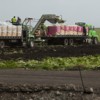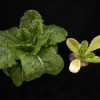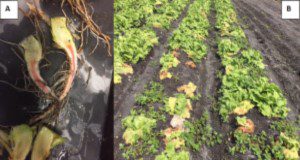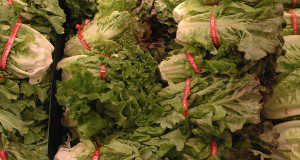Fusarium wilt of lettuce is a disease caused by the fungus Fusarium oxysporum f.sp. lactucae. The disease is present in all lettuce production areas worldwide. Recently this disease has been identified in Florida in localized fields. This new 4-page publication of the UF/IFAS Horticultural Sciences Department presents information about the disease, symptoms, and control measures useful to lettuce growers in Florida. Following these recommendations may help to avoid the spread of this fungus in muck soils at the Everglades Agricultural Area (EAA), where 90% of the lettuce in Florida is planted. Written by Germán V. Sandoya, Jesse J. Murray, Richard N. Raid, and Christian F. Miller.
https://edis.ifas.ufl.edu/hs1385
Tag: Lettuce
Lettuce Cultivars Suitable for Use on Organic Soils in Southern Florida
Lettuce as a commercial crop is planted mainly in organic soils (“muck”) in the Everglades Agricultural Area (EAA) in south Florida. This updated 6-page publication of the UF/IFAS Horticultural Sciences Department presents a summary of previous cultivar releases by UF/IFAS as well as a description of cultivars currently planted in the EAA. Written by German Sandoya and Huangjun Lu.
https://edis.ifas.ufl.edu/hs1225
Selecting Cultivars of Lettuce For Production Using Hydroponics and Protected Culture in Florida
 With correct variety selection and protected culture strategies, lettuce is a crop that can present even the novice grower with a fast-growing commodity for market sale. Includes brief descriptions of hydroponic lettuce production systems, cultivars, and a table summarizing the lettuce types successfully grown in Florida using protected agriculture and hydroponic techniques. This 6-page fact sheet was written by Natalie B. Parkell, Robert C. Hochmuth, and Wanda L. Laughlin, and published by the UF Department of Horticultural Sciences, March 2015. (Photo: UF/IFAS)
With correct variety selection and protected culture strategies, lettuce is a crop that can present even the novice grower with a fast-growing commodity for market sale. Includes brief descriptions of hydroponic lettuce production systems, cultivars, and a table summarizing the lettuce types successfully grown in Florida using protected agriculture and hydroponic techniques. This 6-page fact sheet was written by Natalie B. Parkell, Robert C. Hochmuth, and Wanda L. Laughlin, and published by the UF Department of Horticultural Sciences, March 2015. (Photo: UF/IFAS)
http://edis.ifas.ufl.edu/hs1258
Lettuce Cultivars Suitable for Use in Southern Florida
 Lettuce is an economically important winter vegetable crop in Florida, with approximately 11,000 acres in production and a farm gate value of $40–$50 million annually. Florida lettuce production occurs mainly in the Everglades Agricultural Area (EAA). In recent years, research scientists at the University of Florida conducted variety trials that included the major cultivars of romaine and iceberg types. These trials were conducted on organic soil in the Everglades Agricultural Area and the IFAS-recommended practice was followed. This 3-page fact sheet describes lettuce cultivars suitable for production on organic soils in the EAA of southern Florida. Written by Huangjun Lu, and published by the UF Department of Horticultural Sciences, October 2013.
Lettuce is an economically important winter vegetable crop in Florida, with approximately 11,000 acres in production and a farm gate value of $40–$50 million annually. Florida lettuce production occurs mainly in the Everglades Agricultural Area (EAA). In recent years, research scientists at the University of Florida conducted variety trials that included the major cultivars of romaine and iceberg types. These trials were conducted on organic soil in the Everglades Agricultural Area and the IFAS-recommended practice was followed. This 3-page fact sheet describes lettuce cultivars suitable for production on organic soils in the EAA of southern Florida. Written by Huangjun Lu, and published by the UF Department of Horticultural Sciences, October 2013.
http://edis.ifas.ufl.edu/hs1225
Nitrogen Cycling and Management for Romaine and Crisphead Lettuce Grown on Organic Soils
 Lettuce has rapid growth and reaches harvest in 60–70 days in South Florida. This leads to high demands for nitrogen fertilization during the short growing season. A good N fertilization scheme should reduce costs, conserve natural resources, and minimize negative environmental impacts. The keys to using fertilizer efficiently are understanding the crop nutrient requirements to predict fertilizer needs and management as well as knowing the appropriate amounts to apply. Lettuce growers also need to know the nutritional status of the crop through soil and plant tissue testing. This 4-page fact sheet was written by Luis Santos, Alan L. Wright, Yigang Luo, Huangjun Lu, and D. Calvin Odero, and published by the UF Department of Soil and Water Science, September 2013.
Lettuce has rapid growth and reaches harvest in 60–70 days in South Florida. This leads to high demands for nitrogen fertilization during the short growing season. A good N fertilization scheme should reduce costs, conserve natural resources, and minimize negative environmental impacts. The keys to using fertilizer efficiently are understanding the crop nutrient requirements to predict fertilizer needs and management as well as knowing the appropriate amounts to apply. Lettuce growers also need to know the nutritional status of the crop through soil and plant tissue testing. This 4-page fact sheet was written by Luis Santos, Alan L. Wright, Yigang Luo, Huangjun Lu, and D. Calvin Odero, and published by the UF Department of Soil and Water Science, September 2013.
http://edis.ifas.ufl.edu/ss588
Nitrogen Cycling and Management for Romaine and Crisphead Lettuce Grown on Organic Soils
 Lettuce reaches harvest in 60–70 days in South Florida. This short growing season leads to high demands for nitrogen fertilization to maintain adequate plant-available N concentrations in the soil. Growers need to supply the required amounts of N to obtain high yields. Lettuce growers also need to know the nutritional status of the crop through soil and plant tissue testing. This 4-page fact sheet was written by Luis Santos, Alan L. Wright, Yigang Luo, Huangjun Lu, and D. Calvin Odero, and published by the UF Department of Soil and Water Science, September 2013.
Lettuce reaches harvest in 60–70 days in South Florida. This short growing season leads to high demands for nitrogen fertilization to maintain adequate plant-available N concentrations in the soil. Growers need to supply the required amounts of N to obtain high yields. Lettuce growers also need to know the nutritional status of the crop through soil and plant tissue testing. This 4-page fact sheet was written by Luis Santos, Alan L. Wright, Yigang Luo, Huangjun Lu, and D. Calvin Odero, and published by the UF Department of Soil and Water Science, September 2013.
http://edis.ifas.ufl.edu/ss588

